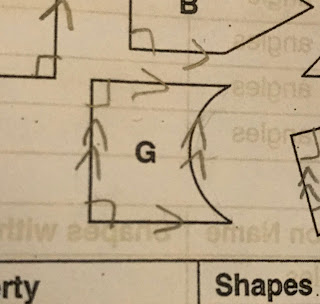Good Questions Lead To Good Questions
This past week, I had the opportunity to learn with the principals and math leads from our district's K-8 elementary schools. Part of the learning we did that day was building content knowledge for teaching mathematics. In our district, we have been doing a lot of learning around making connections between concrete, diagrammatic and symbolic mathematics (my colleague Mike Jacobs blogs about it in detail here, here, here, and here and in other places on his blog). The concrete-diagrammatic-symbolic continuum has had a big impact with our students and helps them develop a deeper understanding of mathematical concepts. When Mike and I were asked to share a couple of mathematics activities with the group, we thought it would be a great idea for them to do some thinking with pattern blocks as they're a readily available resource in our schools.
We began by tweeting an appetizer on Monday from our board math Twitter account, @DCDSBMath:
As far as tweets from the @DCDSBMath account go, this one went fairly viral, reaching approximately 4000 views during its first four days. We held our district Capacity Building sessions with half of our schools attending on Wednesday and half on Thursday so we wanted to have a distinct question for each group in attendance.
The Wednesday school teams got this one:
There was a buzz in the room as soon as the question was posted. School teams worked collaboratively using the pattern blocks to determine what the unit was and what each part was worth as they tried different designs to represent 5/3. Some of my favourites were:
The Thursday group got this question:
We began by tweeting an appetizer on Monday from our board math Twitter account, @DCDSBMath:
As far as tweets from the @DCDSBMath account go, this one went fairly viral, reaching approximately 4000 views during its first four days. We held our district Capacity Building sessions with half of our schools attending on Wednesday and half on Thursday so we wanted to have a distinct question for each group in attendance.
The Wednesday school teams got this one:
There was a buzz in the room as soon as the question was posted. School teams worked collaboratively using the pattern blocks to determine what the unit was and what each part was worth as they tried different designs to represent 5/3. Some of my favourites were:
The Thursday group got this question:
Again, the responses were very creative, with educators laughing and working together to make their 11/9 designs:
In part of the consolidation and group sharing, a question was asked that we did not anticipate:
"How many different combinations of blocks can be used to create 11/9?"
If you have a good question, it usually leads to other good questions! If you consider the four "primary" pattern blocks (the yellow hexagon, the red trapezoid, the blue rhombus and the green triangle), the number of combinations is not infinite. I solved it and am pretty happy with my solution but I'm not going to put it on here. Feel free to dig into it (or any of the other pattern block puzzles above) and share in the comments below or with me @AllenMath.













This is awesome! I love how you are the sharing student work, I love the ability that they can be creative, think about the math and have different answers that are all 'correct.' Well done!
ReplyDelete